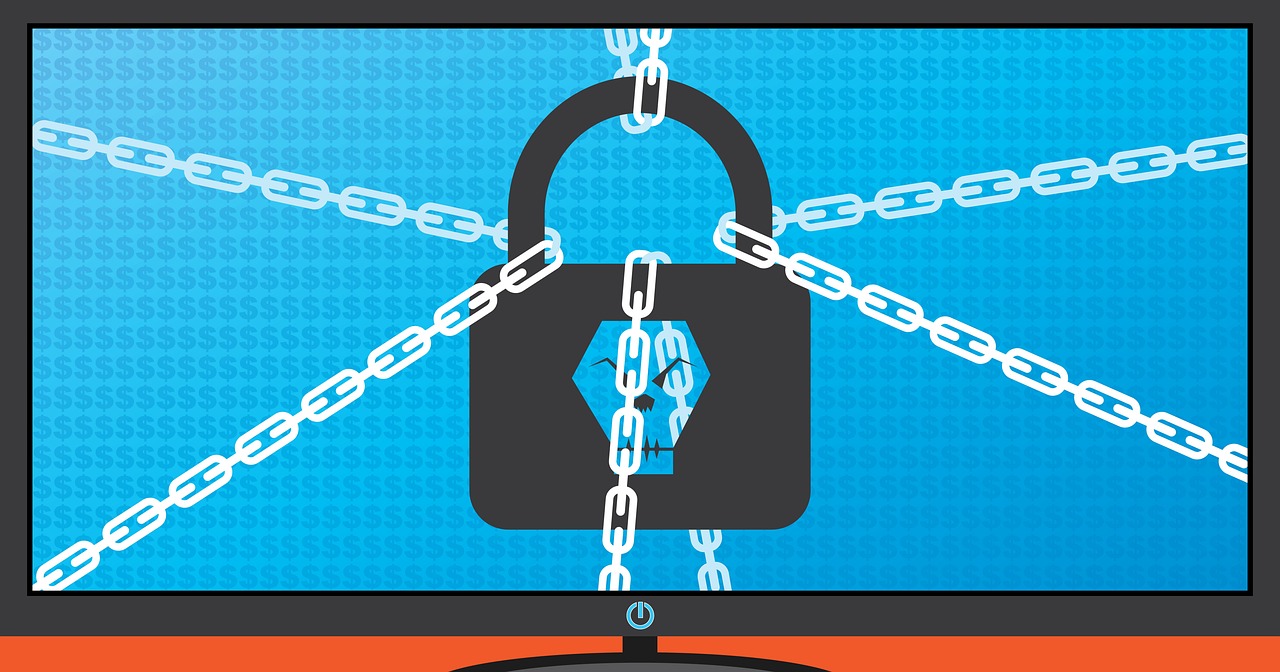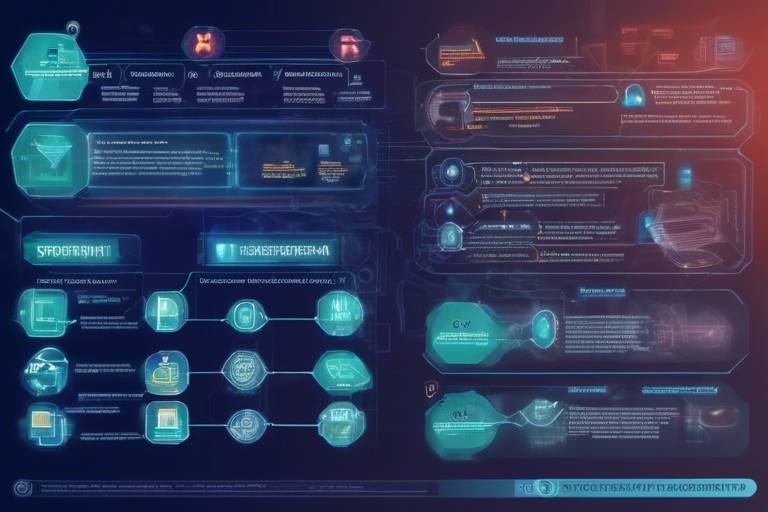The Impact of Cyber Attacks on Small Businesses
In today's digital age, the threat of cyber attacks looms larger than ever, especially for small businesses. These enterprises often lack the robust security measures that larger corporations can afford, making them prime targets for cybercriminals. The consequences of a cyber attack can be staggering, leading to not only immediate financial loss but also long-lasting damage to a company's reputation and operational capabilities. Imagine waking up to find your business's sensitive data compromised, your customer trust eroded, and your daily operations disrupted. It's a nightmare that many small business owners face, and it's crucial to understand the multifaceted impacts of these attacks.
Cyber attacks can manifest in various forms, including phishing schemes, malware infections, and ransomware incidents. Each type of attack poses unique challenges and risks, and understanding these threats is vital for small businesses aiming to safeguard their operations. For instance, a phishing attack may trick employees into revealing sensitive information, while ransomware can lock critical data, demanding a hefty ransom for its release. The reality is that small businesses must be prepared to face these threats head-on, as the repercussions can ripple through every aspect of their operations.
When we talk about the financial impact of cyber attacks, it’s not just about the immediate costs incurred. Small businesses may find themselves grappling with a range of expenses, from IT repairs and data recovery to legal fees and lost revenue. In fact, the financial strain can lead to long-term instability, forcing businesses to make difficult decisions that could affect their future. For example, the average cost of a data breach for small businesses can reach into the thousands, often resulting in a significant portion of their annual revenue being wiped out.
Moreover, the indirect costs associated with cyber attacks can be even more insidious. Reputational damage, for instance, can linger long after the initial incident, as customers may lose faith in a brand that has suffered a breach. This loss of trust can lead to decreased sales and a struggle to attract new customers, creating a vicious cycle that is hard to escape. Small businesses need to realize that the effects of a cyber attack extend beyond immediate financial loss; they can fundamentally alter the landscape of their operations and market position.
Operational disruptions are another critical aspect that small businesses must consider. A successful cyber attack can halt daily operations, leading to significant downtime. This not only affects productivity but can also lead to missed business opportunities and dissatisfied customers. Imagine a restaurant unable to process orders because of a ransomware attack; the impact on sales and customer satisfaction can be devastating. Therefore, it's essential for small businesses to have contingency plans in place to minimize downtime and keep operations running smoothly, even in the face of adversity.
In conclusion, the impact of cyber attacks on small businesses is profound, affecting their financial health, reputation, and operational efficiency. As the digital landscape continues to evolve, so too do the tactics employed by cybercriminals. Small business owners must take proactive steps to protect their enterprises, including investing in cybersecurity measures, training employees, and developing robust recovery plans. By understanding the risks and preparing for potential attacks, small businesses can not only survive but thrive in an increasingly digital world.
- What are the most common types of cyber attacks targeting small businesses?
The most common types include phishing, ransomware, and malware attacks.
- How can small businesses protect themselves from cyber attacks?
Implementing strong cybersecurity measures, conducting regular employee training, and investing in technology are key strategies.
- What should a small business do immediately after a cyber attack?
They should assess the damage, notify affected parties, and begin recovery efforts as soon as possible.
- Is it expensive for small businesses to recover from a cyber attack?
Yes, recovery can be costly, involving IT repairs, legal fees, and potential loss of revenue.

Understanding Cyber Attacks
This article explores the various ways cyber attacks affect small businesses, including financial loss, reputational damage, and operational disruptions, while also discussing prevention strategies and recovery plans.
Cyber attacks are like the unexpected storms that can hit your small business without warning. They come in various forms, each with its unique characteristics and dangers. To effectively safeguard your business, it’s essential to understand the different types of cyber threats that exist and how they can impact your operations. Some of the most common forms of cyber attacks include phishing, malware, and ransomware.
Phishing is often the starting point for many cyber attacks. It involves tricking individuals into providing sensitive information, such as passwords or credit card numbers, usually through deceptive emails or messages. Imagine receiving an email that looks like it’s from your bank, asking you to verify your account details. If you fall for it, the attackers gain access to your sensitive information, which they can exploit for various malicious purposes.
Malware, short for malicious software, is another significant threat. This includes viruses, worms, and Trojans that can infiltrate your systems, causing damage or stealing data. Just like a thief breaking into your home, malware can silently enter your network, wreaking havoc without you even knowing it until it’s too late.
Ransomware takes things a step further. This type of attack locks you out of your own data, demanding a ransom to restore access. It’s akin to someone chaining your front door and demanding payment for the key. For small businesses, the implications can be catastrophic, as downtime and loss of access to critical data can lead to severe operational disruptions.
| Type of Cyber Attack | Description | Potential Impact |
|---|---|---|
| Phishing | Deceptive emails or messages tricking individuals into revealing sensitive information. | Identity theft, financial loss. |
| Malware | Malicious software that damages or disrupts computer systems. | Data loss, system downtime. |
| Ransomware | Locks users out of their data, demanding payment for access. | Operational disruption, financial strain. |
Understanding these threats is crucial for small businesses. By recognizing the signs of a potential attack, you can take proactive measures to protect your valuable data and maintain the integrity of your operations. It's like knowing the weather forecast; if you see a storm coming, you can take shelter before it hits. In the digital world, being prepared means having the right security measures in place to defend against these cyber threats.
- What are the most common types of cyber attacks? The most common types include phishing, malware, and ransomware.
- How can small businesses protect themselves from cyber attacks? Implementing strong cybersecurity measures, employee training, and investing in technology can help.
- What should a business do if it becomes a victim of a cyber attack? Immediate steps include isolating affected systems, notifying stakeholders, and contacting law enforcement.

The Financial Consequences
The financial impact of cyber attacks on small businesses can be nothing short of devastating. When a small business becomes a target, the consequences can ripple through every aspect of its operations, leading to a precarious financial situation. Imagine waking up one morning to find that your entire customer database has been compromised. The immediate thought is panic, but the reality sets in when you start calculating the costs involved. These costs can include recovery expenses, legal fees, and lost revenue, which often lead to long-term financial instability.
Let's break it down further. First, we have the direct costs, which encompass immediate expenses incurred from a cyber attack. This includes IT repairs, data recovery, and possibly even hiring outside experts to help navigate the mess. For small businesses, which typically operate on tight budgets, these costs can quickly add up, straining their limited resources. For instance, a small business might find themselves paying thousands of dollars for a cybersecurity firm to help mitigate the damage, which could have been used for growth initiatives instead.
Direct costs are often the most visible and pressing financial consequences of a cyber attack. They can include:
- IT Repairs: The cost of fixing systems and restoring services can be astronomical.
- Data Recovery: Recovering lost or compromised data often necessitates specialized services.
- Ransom Payments: In the case of ransomware attacks, businesses might feel pressured to pay to regain access to their data.
Then there are the legal fees that arise from data breaches. Small businesses may face lawsuits from affected customers or regulatory fines for failing to protect sensitive information. This can add a significant financial burden, complicating recovery efforts. For example, a company might end up spending thousands of dollars in legal consultations and settlements, which could have been allocated to essential business functions.
Another critical factor is the loss of revenue that often follows a cyber attack. This can occur due to operational downtime, which halts business activities, or diminished customer trust, which can deter potential clients. When customers hear about a data breach, they may think twice about doing business with that company. The loss of revenue can significantly hinder a small business's ability to recover and thrive. In fact, studies have shown that many small businesses that experience a cyber attack close within six months due to financial strain.
While direct costs are immediate, the indirect costs can be even more insidious. These include reputational damage and customer attrition, which can have lasting effects on small businesses. The hidden costs often exacerbate the financial strain caused by cyber incidents. For instance, a business may lose long-term customers who feel their data is no longer safe, leading to a decline in sales that can take years to recover from.
In conclusion, the financial consequences of cyber attacks on small businesses are profound and multifaceted. It's not just about the immediate expenses; it's also about the long-term implications that can threaten the very existence of a business. Being prepared and informed is crucial for small businesses to navigate these challenges effectively.
Q: What are the most common types of cyber attacks that affect small businesses?
A: The most common types include phishing, malware, ransomware, and denial-of-service attacks. Each of these poses unique challenges and requires specific prevention strategies.
Q: How can small businesses protect themselves from cyber attacks?
A: Small businesses can protect themselves by implementing robust cybersecurity measures, including employee training, investing in technology, and having a solid incident response plan.
Q: What should a small business do immediately after a cyber attack?
A: They should assess the damage, notify affected parties, and begin recovery efforts, including contacting cybersecurity professionals and legal advisors.

Direct Costs
When a cyber attack strikes, small businesses often find themselves facing a barrage of that can drain their financial resources faster than a sinking ship. These immediate expenses arise from the need to address the aftermath of the attack and can include a variety of crucial elements. Let's break down some of these costs to understand the true impact on a small business.
First and foremost, there's the cost of IT repairs. After a breach, businesses typically need to call in IT professionals to assess the damage, repair systems, and ensure that vulnerabilities are patched. This service can be quite pricey, especially for small businesses that may not have an in-house IT team. Furthermore, the costs don't stop there; once the systems are back up and running, businesses often need to invest in additional security measures to prevent future attacks. This can include purchasing new software, hardware, or even hiring external consultants for ongoing support.
Another significant direct cost comes from data recovery. In many cases, critical data may be lost or compromised during an attack. Businesses often need to engage specialized data recovery services, which can be incredibly expensive. This process can take time and resources that small businesses simply cannot afford to waste. Think of it as trying to retrieve a lost treasure; the more valuable the data, the more you’ll have to spend to get it back.
Additionally, small businesses may face costs associated with forensic investigations. After an attack, it's essential to understand how the breach occurred and what data may have been compromised. This often requires hiring cybersecurity experts who can conduct a thorough investigation. These services can add up quickly, leaving businesses grappling with even more financial strain.
To illustrate the potential impact of direct costs, consider the following table:
| Type of Direct Cost | Estimated Cost |
|---|---|
| IT Repairs | $5,000 - $20,000 |
| Data Recovery Services | $1,000 - $10,000 |
| Forensic Investigations | $2,000 - $15,000 |
| New Security Measures | $3,000 - $25,000 |
As you can see, the direct costs of a cyber attack can quickly escalate, potentially leading to a financial crisis for small businesses. These expenses are not just one-off payments; they can create a ripple effect that hampers cash flow and limits the ability to invest in growth opportunities. In essence, the financial burden of direct costs can transform a minor incident into a major setback, forcing small businesses to rethink their operational strategies and financial planning.
In conclusion, understanding the direct costs associated with cyber attacks is crucial for small businesses. By being aware of these potential expenses, businesses can better prepare themselves and allocate resources to mitigate the impact of such incidents. Remember, investing in cybersecurity measures today can save you from a financial nightmare tomorrow!
- What are the most common direct costs associated with cyber attacks? The most common direct costs include IT repairs, data recovery services, forensic investigations, and new security measures.
- How can small businesses prepare for potential direct costs? Small businesses can prepare by investing in cybersecurity measures, conducting regular security audits, and setting aside a budget for emergency expenses.
- Are there any insurance options for cyber attacks? Yes, many insurance companies offer cyber liability insurance that can help cover the costs associated with a cyber attack.

Legal Fees
When a cyber attack occurs, one of the most immediate concerns for small businesses is the potential for to accumulate rapidly. These expenses can arise from various sources, including legal consultations, potential lawsuits filed by affected customers, and regulatory fines imposed by governing bodies. The aftermath of a data breach often involves a complex web of legal obligations that can leave small business owners feeling overwhelmed.
For instance, if customer data is compromised, businesses may face class-action lawsuits from clients whose personal information was exposed. The costs associated with defending against these lawsuits can be staggering, especially for small businesses that operate on tight budgets. Additionally, businesses may need to invest in legal expertise to navigate the intricacies of data protection laws, which can vary significantly by region.
Here's a breakdown of some common legal fees that small businesses might encounter following a cyber attack:
- Consultation Fees: Engaging with legal experts to understand the implications of the breach.
- Litigation Costs: Expenses related to defending against lawsuits, which can include court fees and attorney fees.
- Regulatory Fines: Potential fines from government agencies for failing to protect sensitive data.
- Settlement Costs: If a lawsuit is settled out of court, the costs can still be significant.
Moreover, the legal landscape surrounding cyber security is constantly evolving. Small businesses must stay informed about new regulations and compliance requirements to avoid further legal entanglements. This often necessitates ongoing legal counsel, which adds another layer of expense. In essence, the financial burden of legal fees can not only cripple a small business's immediate recovery efforts but can also have long-term implications for its viability.
In conclusion, understanding the potential for legal fees in the wake of a cyber attack is crucial for small businesses. By preparing for these expenses and seeking proactive legal advice, businesses can better navigate the stormy waters of post-attack recovery.
- What should I do immediately after a cyber attack? It's crucial to assess the damage, inform your incident response team, and consult with legal experts to understand your obligations.
- How can I reduce the risk of a cyber attack? Implementing robust cybersecurity measures, training employees, and investing in technology can significantly reduce risks.
- What are the signs of a cyber attack? Unusual system behavior, unexpected downtime, and unauthorized access attempts are common indicators of a cyber attack.
- Can I recover legal fees after a cyber attack? Depending on the circumstances, you may be able to recover some legal fees through insurance or settlements, but it's best to consult with a legal professional.

Loss of Revenue
The loss of revenue following a cyber attack can be a crippling blow for small businesses. Imagine waking up one day to find your operations halted, customer transactions disrupted, and your reputation in tatters. The reality is, when a cyber attack strikes, it doesn't just affect your data; it directly impacts your bottom line. The immediate fallout often includes operational downtime, which can lead to a significant loss of sales. For instance, if a retail business experiences a cyber attack during peak shopping hours, the missed sales opportunities can be staggering.
Moreover, the aftermath of such attacks can create a ripple effect that extends beyond immediate financial losses. Customers may feel uneasy about returning to a business that has been compromised, leading to a decline in customer trust. This decline can translate into long-term revenue losses as loyal customers seek alternatives. It's essential to understand that these losses are not just a temporary setback; they can create a challenging environment for recovery. In fact, studies have shown that many small businesses that suffer a cyber attack may never fully recover, as they struggle to regain the trust of their clientele.
Additionally, the long-term impact on revenue can be exacerbated by the costs associated with recovery efforts. Small businesses often find themselves allocating a significant portion of their resources to remediate the damage caused by the attack. This includes:
- Investing in new security measures
- Covering legal fees related to data breaches
- Managing public relations efforts to repair their image
All these factors contribute to a challenging financial landscape for small businesses post-attack. They may find themselves in a position where they are not only trying to recover lost revenue but also facing increased operational costs. The situation can feel overwhelming, but understanding these dynamics is the first step in mitigating potential losses in the future.

Indirect Costs
When we think about the financial impact of cyber attacks, we often focus on the direct costs like recovery expenses and legal fees. However, the can be just as damaging, if not more so, to small businesses. These hidden costs can linger long after the initial incident, creating a ripple effect that can destabilize operations and hinder growth. For instance, the reputational damage caused by a data breach can lead to a significant loss of customer trust, which, in turn, affects sales and revenue. It's like a snowball effect—once it starts rolling, it can become increasingly difficult to stop.
One of the most significant indirect costs is the potential loss of customers. When clients hear about a cyber attack on a business, their immediate reaction may be to question the safety of their own data. This loss of confidence can lead to a decrease in customer loyalty, and as customers leave, the business faces not only reduced income but also the hefty costs associated with acquiring new customers. In fact, studies show that it can cost five times more to attract a new customer than to keep an existing one.
Additionally, businesses may face increased operational costs as they scramble to improve their security measures post-attack. This can include hiring new staff, investing in advanced technology, and implementing comprehensive training programs—all of which require significant financial resources. Consequently, these expenses can divert funds from other critical areas of the business, stunting growth and innovation.
Moreover, the psychological toll on employees cannot be overlooked. After a cyber attack, there may be a pervasive sense of fear and uncertainty among staff. This can lead to decreased morale and productivity, further complicating recovery efforts. Employees may feel less secure in their jobs, which can result in higher turnover rates. When valued staff members leave, the costs of recruiting and training new employees can add to the financial burden.
In summary, while direct costs are often the first to be acknowledged, the of cyber attacks can be equally, if not more, damaging. Small businesses must be vigilant in addressing these hidden threats, as the long-term implications can significantly hinder their ability to recover and thrive in an increasingly digital world.
- What are the most common types of cyber attacks faced by small businesses?
Small businesses often encounter phishing, ransomware, and malware attacks. Understanding these threats is essential for implementing effective security measures.
- How can small businesses recover from a cyber attack?
Recovery involves having a solid plan that includes an incident response team, data backup solutions, and effective communication strategies to restore customer trust.
- What preventative measures can small businesses take?
Regular employee training on cybersecurity, investing in advanced technology, and developing a robust security policy can significantly reduce the risk of cyber attacks.

Reputational Damage
Cyber attacks can severely damage a small business's reputation, leading to a ripple effect that can impact customer loyalty, sales, and even future growth. When a breach occurs, it’s not just the immediate loss of data that matters; it’s how customers perceive the business afterward. Trust is a fragile thing, and once it’s broken, it can take a long time to rebuild. Imagine walking into a store and finding that the last time you shopped there, your personal information was compromised. You’d likely think twice before returning, right? This is the reality for many customers after a cyber incident.
After a cyber attack, customers may feel vulnerable and question the security of their own data. They might wonder:
- Is my information safe here?
- What if my data was leaked?
- Can I trust this business again?
These questions can lead to a significant decline in customer trust, which is crucial for small businesses that thrive on repeat customers and strong community ties. The loss of trust can manifest in various ways, including:
- Decreased sales as customers opt for competitors.
- Negative reviews and feedback on social media.
- Difficulty in acquiring new customers.
To illustrate the impact, consider the following table that outlines the potential consequences a small business may face after a cyber attack:
| Consequence | Impact |
|---|---|
| Loss of Customer Trust | Immediate drop in sales, long-term brand damage |
| Negative Publicity | Increased scrutiny from media and competitors |
| Customer Attrition | Higher churn rates, reduced market share |
| Difficulty in Rebuilding Reputation | Increased marketing costs, prolonged recovery time |
In the aftermath of a cyber attack, small businesses must take proactive steps to mitigate reputational damage. Effective communication is key. Customers appreciate transparency, so informing them about the steps being taken to secure their data can help restore some level of trust. Additionally, investing in reputation management strategies is essential. This may include monitoring online reviews, engaging with customers on social media, and addressing concerns head-on. It’s like putting a band-aid on a wound; while it won’t heal overnight, it’s a step toward recovery.
Ultimately, the effects of reputational damage can be long-lasting and far-reaching. Small businesses must recognize that protecting their reputation is as critical as safeguarding their data. By prioritizing customer trust and implementing effective recovery strategies, they can not only survive a cyber attack but also emerge stronger and more resilient.

Customer Trust
Maintaining is essential for small businesses, and it's often a fragile thing. Think of it like a glass vase; once it's shattered, no amount of glue can truly restore it to its original form. Cyber attacks can dramatically erode this trust, leaving customers feeling vulnerable and questioning the security of their personal information. When a breach occurs, customers may wonder, "If my data isn't safe here, where can it be?" This skepticism can lead to significant challenges in retaining existing customers and attracting new ones.
In the digital age, where information is just a click away, customers are increasingly aware of the potential risks associated with sharing their data. They often look for businesses that prioritize security and transparency. If a small business suffers a cyber attack, the immediate fallout can include a loss of customer confidence. Customers may choose to take their business elsewhere, opting for competitors that they perceive as being more secure. This shift not only impacts immediate sales but can also have long-term effects on a brand's reputation.
To rebuild trust after a cyber incident, small businesses must take proactive steps to communicate openly with their customers. This can include:
- Informing customers about the nature of the breach.
- Explaining what measures are being taken to rectify the situation.
- Offering support services, such as credit monitoring, to affected customers.
Furthermore, investing in reputation management strategies can significantly aid in restoring customer confidence. This involves not just addressing the breach but also showcasing the steps taken to enhance security measures moving forward. By demonstrating a commitment to safeguarding customer data, small businesses can begin to mend the trust that was lost.
Ultimately, the journey to regain customer trust is not a sprint but a marathon. It requires consistent effort, transparent communication, and a genuine commitment to improving security practices. In a world where customers have countless options at their fingertips, rebuilding trust is crucial for long-term success and sustainability.
- What should I do if my business experiences a cyber attack?
It's essential to have a response plan in place. Start by assessing the damage, informing affected customers, and working with cybersecurity professionals to contain the breach. - How can I prevent cyber attacks in my small business?
Implementing robust cybersecurity measures, such as employee training, regular software updates, and investing in advanced security technologies, can significantly reduce the risk of attacks. - How long does it take to recover from a cyber attack?
Recovery time varies based on the severity of the attack and the preparedness of the business. Having a solid recovery plan can expedite the process.

Brand Recovery Strategies
After a cyber attack, rebuilding your brand's reputation is not just a task; it's a necessity. The road to recovery can feel daunting, but with the right strategies in place, small businesses can emerge stronger than ever. First and foremost, transparency is key. Customers appreciate honesty, so it’s crucial to communicate openly about what happened, how it affects them, and what steps are being taken to rectify the situation. This approach not only fosters trust but also demonstrates that your business values its customers.
Another vital strategy is to invest in reputation management. This can involve monitoring online reviews, engaging with customers on social media, and even leveraging public relations to share positive stories about your business. Consider creating a dedicated section on your website that addresses the incident and outlines your commitment to security and customer safety. This proactive stance can significantly aid in restoring public confidence.
Moreover, customer engagement should be a priority. Reconnecting with your audience through personalized communication can make a significant difference. Send out newsletters, offer discounts, or host events to show your customers that you are committed to making things right. Engaging with your community not only helps to rebuild trust but also enhances customer loyalty in the long run.
Lastly, implementing improved security measures can serve as a powerful message to your customers that you are serious about protecting their data. Share these updates with your audience to reassure them that their information is safe with you. By taking these steps, small businesses can not only recover from a cyber attack but also strengthen their brand in the process.
- What should I do immediately after a cyber attack?
First, assess the damage and contain the breach. Notify affected customers and begin implementing your incident response plan.
- How can I prevent future cyber attacks?
Invest in cybersecurity training for employees, update software regularly, and use strong passwords to protect your systems.
- Is it necessary to hire a cybersecurity expert?
While not always necessary, having an expert on your team can help identify vulnerabilities and develop robust security measures.

Operational Disruptions
Cyber attacks can create significant for small businesses, often leading to a ripple effect that impacts various aspects of their operations. When a cyber attack occurs, it doesn't just affect the immediate systems; it can halt business functions, disrupt communication channels, and even delay service delivery. Imagine trying to run a restaurant without access to your reservation system or a retail store without the ability to process transactions. These scenarios highlight how a cyber attack can bring operations to a standstill, leaving businesses scrambling to regain normalcy.
One of the most immediate consequences of a cyber attack is downtime. This term refers to periods when a business's operations are halted due to system failures or security breaches. The effects of downtime can be profound:
- Service Delays: Customers expect timely service; any delay can lead to dissatisfaction and loss of business.
- Financial Loss: Each minute of downtime can translate into lost revenue, especially for e-commerce businesses that rely on constant online access.
- Increased Costs: The need for emergency IT support or overtime for employees to catch up can inflate operational costs.
Moreover, the impact of a cyber attack extends beyond just immediate financial losses. It can also lead to a significant decline in employee productivity. When systems are compromised, employees may find themselves unable to access essential tools and information needed to perform their jobs effectively. This disruption can lead to frustration and decreased morale, creating a challenging work environment. For example, if a marketing team cannot access their analytics tools due to a cyber attack, their ability to make informed decisions is severely hindered.
To mitigate these operational disruptions, small businesses must develop a robust cybersecurity strategy that includes proactive measures. This strategy should encompass regular system updates, employee training on security protocols, and the implementation of advanced technology to monitor for potential threats. Additionally, having a clear incident response plan can help businesses quickly address issues as they arise, minimizing downtime and maintaining productivity.
In conclusion, the operational disruptions caused by cyber attacks can have far-reaching consequences for small businesses. From halted services to decreased employee productivity, the impacts are multifaceted and can lead to a long road to recovery. Therefore, investing in cybersecurity and preparing for potential incidents is not just a good practice; it is essential for survival in today’s digital landscape.
- What are the most common types of cyber attacks faced by small businesses?
Phishing, ransomware, and malware are among the most common types of cyber attacks that small businesses encounter. - How can small businesses prepare for potential cyber attacks?
Implementing employee training, investing in cybersecurity technologies, and establishing an incident response plan are key steps in preparing for cyber threats. - What should a small business do immediately after a cyber attack?
Immediately assess the damage, notify affected parties, and begin implementing the recovery plan to restore operations.

Downtime Effects
When a cyber attack strikes, the immediate aftermath often involves a significant amount of downtime, which can be a major blow to any small business. Imagine a bustling café suddenly forced to close its doors because of a ransomware attack; not only does it lose revenue during the shutdown, but it also risks losing loyal customers who might turn to competitors for their daily fix. This situation is not just hypothetical; it happens all too often in the digital age.
The effects of downtime can ripple through various aspects of a business. Firstly, there's the obvious financial impact. Every minute a business is offline translates to lost sales opportunities. According to a recent study, small businesses can lose up to $8,000 per hour during downtime caused by cyber incidents. For many, this loss can be devastating, especially if the downtime extends for days or even weeks.
Moreover, downtime can lead to a decrease in customer satisfaction. Customers expect services to be available at all times, and any interruption can lead to frustration. If a customer can't access a service or product they need, they may not return, opting instead for a competitor who is operational. This shift can create a long-term impact on a business's market position and profitability.
In addition to financial losses and customer dissatisfaction, downtime can also disrupt internal operations. Employees may find themselves unable to perform their duties, leading to a decrease in productivity. For instance, if a marketing team can't access their tools or databases due to a cyber attack, campaigns may be delayed, and important deadlines could be missed. This not only affects the current workload but can also have a cascading effect on future projects and planning.
To illustrate the potential impact of downtime, consider the following table:
| Type of Cost | Estimated Impact |
|---|---|
| Revenue Loss | $8,000 per hour |
| Customer Attrition | 20% potential loss of loyal customers |
| Employee Productivity | Up to 50% decrease during downtime |
It's clear that the effects of downtime extend far beyond just the moment of the attack. The longer a business remains offline, the more profound the consequences become. Therefore, preparing for potential downtime and having a robust recovery plan in place is not just advisable; it's essential. Businesses must invest in strategies that not only minimize the risk of cyber attacks but also ensure a swift recovery should an incident occur.
- What is downtime in the context of cyber attacks? Downtime refers to the period during which a business is unable to operate due to disruptions caused by cyber incidents, leading to lost revenue and productivity.
- How can small businesses prepare for potential downtime? Small businesses can prepare by implementing robust cybersecurity measures, training employees, and developing a solid incident response and recovery plan.
- What are the long-term effects of downtime on a business? Long-term effects can include loss of customer trust, reduced market share, and ongoing financial instability.

Impact on Employee Productivity
The impact of cyber attacks on employee productivity can be profound and multifaceted. When a small business experiences a cyber incident, the immediate aftermath often leads to a chaotic environment where employees are left scrambling to understand the situation. This disruption not only halts normal operations but also creates a sense of uncertainty and anxiety among staff members. Imagine trying to focus on your tasks while knowing that sensitive company data might be compromised. It's like trying to work in a room filled with distractions; your mind just can't settle.
During such incidents, the productivity of employees can plummet for several reasons:
- Increased Stress Levels: The fear of potential job loss or the repercussions of a data breach can weigh heavily on employees, causing stress that hampers their ability to concentrate.
- Time Spent on Recovery: Employees may be pulled away from their regular responsibilities to assist with recovery efforts, such as data restoration or system checks. This diversion can lead to unfinished projects and missed deadlines.
- Training and Awareness Programs: After a cyber attack, businesses often need to implement new training programs to educate staff on security protocols. While essential, these programs can temporarily disrupt the workflow.
Furthermore, the impact on employee morale should not be underestimated. When a company suffers a cyber attack, employees may feel less secure in their positions, leading to lower engagement levels. This can create a cycle of decreased productivity, as disengaged employees are less likely to put forth their best efforts. In fact, studies have shown that organizations that experience cyber incidents often see a drop in overall employee satisfaction, which can take months, if not years, to rebuild.
To mitigate these effects, small businesses should prioritize cybersecurity training and awareness programs. By equipping employees with the knowledge to recognize potential threats, businesses can empower their staff to act as the first line of defense. Additionally, fostering a culture of open communication can help alleviate fears and encourage employees to speak up about security concerns. Just like a well-oiled machine, when each part works together harmoniously, the entire organization can function more effectively, even in the face of challenges.
In summary, the impact of cyber attacks on employee productivity is significant and far-reaching. By addressing these challenges proactively, small businesses can not only protect their operations but also create a resilient workforce capable of navigating the complexities of the digital age.
Q1: What are the common types of cyber attacks that affect small businesses?
A1: Common types of cyber attacks include phishing, ransomware, malware, and denial-of-service attacks. Each of these poses unique challenges and requires different strategies for prevention and recovery.
Q2: How can small businesses prepare for a cyber attack?
A2: Small businesses can prepare by implementing strong cybersecurity measures, conducting regular employee training, and developing a comprehensive incident response plan. Investing in technology and maintaining data backups are also crucial steps.
Q3: What should a small business do immediately after a cyber attack?
A3: Immediately after a cyber attack, a small business should activate its incident response plan, assess the extent of the damage, notify affected parties, and begin recovery efforts, including data restoration and system checks.

Prevention Strategies
In today's digital landscape, safeguarding your small business from cyber threats is not just an option—it's a necessity. The good news is that there are several practical strategies you can implement to enhance your cybersecurity posture. First and foremost, employee training is paramount. Regular training sessions can arm your staff with the knowledge they need to recognize potential threats like phishing emails or suspicious downloads. Imagine your employees as the first line of defense; if they are well-informed, they can spot a cyber threat before it becomes a problem.
Moreover, investing in technology is crucial. Utilizing advanced cybersecurity tools such as firewalls, anti-virus software, and encryption can significantly bolster your defenses against evolving cyber threats. These technologies act like a security system for your business, protecting sensitive data from unauthorized access. For instance, a robust firewall can help filter out malicious traffic, while encryption ensures that even if data is intercepted, it remains unreadable to cybercriminals.
Another vital strategy is to regularly update your software and systems. Cyber attackers often exploit vulnerabilities in outdated software, so keeping everything up-to-date is essential. This includes not only your operating system but also any applications your business relies on. Additionally, consider implementing multi-factor authentication (MFA). This adds an extra layer of security, requiring users to verify their identity through multiple means before accessing sensitive information.
Furthermore, establishing a comprehensive cybersecurity policy is a must. This policy should outline acceptable use of technology, data protection protocols, and incident response procedures. It serves as a roadmap for your employees, guiding them on how to handle various situations related to cybersecurity. Regularly reviewing and updating this policy ensures that it remains relevant in the face of new threats.
Lastly, consider conducting regular security audits. These audits can help identify vulnerabilities within your systems and processes, allowing you to address them before they can be exploited. By taking these proactive measures, you can significantly reduce the risk of a cyber attack, ensuring that your small business remains resilient in the face of adversity.
- What are the most common types of cyber attacks faced by small businesses? Small businesses often face phishing attacks, ransomware, and malware infections.
- How often should I conduct employee training on cybersecurity? It's recommended to conduct training at least once a year, with additional sessions whenever new threats emerge.
- What should I do if my business experiences a cyber attack? Immediately contact your incident response team, assess the damage, and begin recovery procedures.
- Is investing in cybersecurity technology worth it for small businesses? Absolutely! The cost of a cyber attack can far exceed the investment in preventative technologies.

Employee Training
In the ever-evolving landscape of cybersecurity, stands out as a crucial pillar for safeguarding small businesses against cyber attacks. Think of your employees as the first line of defense; if they're well-informed, they can effectively thwart potential threats before they escalate. Regular training sessions not only enhance awareness but also empower employees to recognize and respond to various cyber threats, such as phishing scams and malware attacks.
To maximize the effectiveness of training, it's essential to adopt a comprehensive approach that includes both theoretical knowledge and practical exercises. For instance, you might want to cover the following key areas during training:
- Understanding Cyber Threats: Employees should learn about different types of cyber threats, how they operate, and their potential impact on the business.
- Safe Internet Practices: Training should emphasize the importance of safe browsing habits, recognizing suspicious emails, and avoiding unsafe downloads.
- Data Protection Protocols: Employees must understand how to handle sensitive information securely, including the use of strong passwords and data encryption.
Moreover, incorporating real-life scenarios during training can significantly enhance retention and understanding. For example, conducting simulated phishing attacks can help employees practice identifying fraudulent emails in a controlled environment. This hands-on approach not only builds confidence but also reinforces the lessons learned.
Another effective strategy is to establish a culture of cybersecurity within the organization. This means making cybersecurity a part of the daily conversation. Encourage employees to ask questions, share experiences, and report suspicious activities without fear of repercussions. By fostering an open dialogue about cybersecurity, you're more likely to create a vigilant workforce that prioritizes security.
Lastly, consider scheduling regular refresher courses to keep cybersecurity at the forefront of your employees' minds. Cyber threats are constantly evolving, and ongoing training ensures your team remains prepared to tackle new challenges as they arise. Remember, investing in employee training is not just a checkbox on a compliance list; it's a proactive strategy that can save your business from the devastating effects of a cyber attack.
Q1: How often should employee training on cybersecurity be conducted?
A1: Ideally, employee training should be conducted at least once a year, with refresher courses or updates every six months to keep up with evolving threats.
Q2: What are some common signs of a phishing email?
A2: Common signs include poor grammar, generic greetings, urgent requests for personal information, and suspicious links.
Q3: How can I measure the effectiveness of the training?
A3: You can measure effectiveness through quizzes, simulated attacks, and employee feedback to assess knowledge retention and application.

Investing in Technology
In today's digital landscape, investing in technology is not just an option for small businesses; it's a necessity. With cyber threats evolving at a rapid pace, the right technology can serve as a formidable shield against potential attacks. Think of it as equipping your business with a high-tech fortress where your data and operations are safeguarded from intruders. But what does this investment entail? Let's dive into some key aspects that small businesses should consider when enhancing their cybersecurity posture.
First and foremost, firewalls are your first line of defense. They act as barriers between your internal network and external threats, filtering incoming and outgoing traffic based on predetermined security rules. Investing in a robust firewall can significantly decrease the chances of unauthorized access to your sensitive data. But remember, a firewall is only as good as its configuration. Regular updates and monitoring are essential to ensure it remains effective against new threats.
Next up, consider encryption technologies. Encryption scrambles your data, making it unreadable to anyone who doesn't possess the decryption key. This is particularly crucial for sensitive customer information, such as credit card details and personal identification. By implementing encryption, even if a cybercriminal manages to breach your defenses, the data they steal will be virtually useless without the key to unlock it.
Moreover, investing in intrusion detection systems (IDS) can provide an additional layer of security. These systems monitor your network for suspicious activity and alert you to potential breaches in real-time. Imagine having a security guard who never sleeps and is always on the lookout for unusual behavior. That’s what an IDS does for your digital environment.
Lastly, consider the importance of regular software updates. Cybercriminals often exploit vulnerabilities in outdated software. By keeping your systems updated, you close off potential entry points for attackers. This might seem like a minor task, but it can have a significant impact on your overall security posture.
To sum it up, investing in technology is about creating a comprehensive security strategy that incorporates various tools and practices. Here’s a quick overview of the technology investments that can bolster your defenses:
| Technology | Purpose |
|---|---|
| Firewalls | Filter traffic and block unauthorized access |
| Encryption | Protect sensitive data from unauthorized access |
| Intrusion Detection Systems | Monitor network for suspicious activities |
| Regular Software Updates | Close vulnerabilities and enhance security |
In conclusion, the landscape of cybersecurity is constantly changing, and small businesses must stay ahead of the curve by investing in the right technologies. By doing so, they not only protect their valuable assets but also gain peace of mind, allowing them to focus more on growth and less on potential threats. Remember, in the world of cybersecurity, it’s better to be proactive than reactive.
- What is the most important technology for small businesses to invest in for cybersecurity?
While all technologies play a crucial role, firewalls and encryption are often considered the most critical first steps in establishing a robust security posture. - How often should small businesses update their software?
It's best to update software as soon as updates are available to ensure the latest security patches are applied. - Can small businesses afford advanced cybersecurity technologies?
Investing in cybersecurity is essential for long-term survival. Many cost-effective solutions are available that can fit a small business budget.

Recovery Plans
Having a solid recovery plan in place is essential for small businesses to respond effectively to cyber attacks. Think of your recovery plan as a safety net; it’s there to catch you when the unexpected happens. A well-structured recovery strategy not only helps mitigate the immediate damage caused by an attack but also lays the groundwork for future resilience. So, what does an effective recovery plan look like? Let’s dive into some key components that every small business should consider.
First and foremost, establishing an incident response team is crucial. This team acts as the first line of defense when a cyber incident occurs. Comprised of key personnel from various departments—such as IT, HR, and communications—this team ensures a coordinated approach to managing the incident. They are responsible for executing the recovery plan, assessing damage, and communicating with stakeholders. Imagine them as the emergency responders of your business, equipped to tackle the chaos that ensues after an attack.
Next, implementing data backup solutions is critical. Regular backups can be a lifesaver, allowing small businesses to restore lost data quickly and efficiently after an attack. Think of your data as the lifeblood of your business; losing it can be catastrophic. By regularly backing up your data, you can ensure that you have a copy to fall back on, minimizing downtime and operational disruptions. Many businesses opt for a combination of on-site and cloud-based backup solutions to provide an added layer of security. This dual approach not only protects against data loss but also enhances accessibility in the event of a cyber incident.
Additionally, maintaining clear communication with your customers and stakeholders during a crisis is vital. Transparency builds trust, and how you handle a cyber attack can significantly impact your reputation. Consider drafting a communication plan that outlines how and when you will inform your customers about the incident, the steps you are taking to resolve it, and what measures you are implementing to prevent future occurrences. This proactive approach not only reassures your customers but also demonstrates your commitment to safeguarding their information.
Finally, regular testing and updating of your recovery plan are essential. Cyber threats are constantly evolving, and your recovery plan should adapt to these changes. Schedule routine drills to simulate a cyber attack and evaluate your response effectiveness. After each drill, gather feedback and make necessary adjustments to your plan. This ongoing process will help ensure that your business is always prepared for the unexpected, making your recovery plan a living document that evolves alongside your business.
- What is the first step in creating a recovery plan?
The first step is to form an incident response team that will lead the recovery efforts and develop a comprehensive strategy. - How often should I back up my data?
It is advisable to back up your data at least once a day, but more frequent backups may be necessary depending on your business operations. - What should I include in my communication plan?
Your communication plan should include information on how to notify customers, what information to share, and the timeline for updates.

Incident Response Team
Establishing an is one of the most critical steps a small business can take to prepare for potential cyber attacks. Think of this team as your organization's first line of defense, a group of dedicated individuals who are trained to handle security incidents swiftly and effectively. The primary goal of this team is to mitigate damage, recover lost data, and restore normal operations as quickly as possible. Having a well-defined incident response plan in place can significantly reduce the chaos that often follows a cyber attack.
So, who should be on your incident response team? Typically, this team consists of a mix of IT professionals, legal advisors, and communication experts. Each member plays a unique role, ensuring that all aspects of the incident are covered. For example, IT personnel focus on technical recovery, while legal advisors navigate the complexities of compliance and potential litigation. Communication experts help manage internal and external communications, ensuring that stakeholders are informed without compromising sensitive information.
Moreover, regular training and drills are essential for keeping the incident response team sharp. These exercises simulate various attack scenarios, allowing team members to practice their roles and refine their strategies. By engaging in these drills, the team can identify weaknesses in the response plan and make necessary adjustments, ultimately enhancing the organization's overall resilience against cyber threats.
Additionally, it’s important to establish clear communication channels within the incident response team. This ensures that everyone is on the same page during a crisis. A well-coordinated response can make all the difference in minimizing damage and restoring operations. Consider implementing a centralized communication platform where team members can share real-time updates and collaborate effectively.
In summary, an incident response team is not just a luxury for small businesses; it's a necessity. By investing in a dedicated team and a solid response plan, you are not only safeguarding your business against potential attacks but also building a culture of security awareness that permeates the entire organization. Remember, the quicker you can respond to an incident, the less damage you will incur—both financially and reputationally.
- What is the primary role of an incident response team?
The primary role is to manage and mitigate the impact of cyber incidents, ensuring a swift recovery and minimal disruption to business operations. - Who should be included in the incident response team?
The team should ideally include IT professionals, legal advisors, communication experts, and any other relevant personnel who can contribute to the response effort. - How often should incident response drills be conducted?
It is recommended to conduct these drills at least bi-annually to ensure that all team members are familiar with their roles and the response plan. - What are the benefits of having an incident response team?
Benefits include quicker recovery from incidents, reduced financial losses, and improved organizational resilience against future attacks.

Data Backup Solutions
In the digital age, where data is the lifeblood of any business, having robust is not just a luxury; it's a necessity. Imagine waking up one day to find that all your crucial business information has vanished due to a cyber attack. The panic sets in, and you realize that without a solid backup plan, your small business could be staring down the barrel of a financial disaster. The good news is that implementing effective data backup solutions can significantly mitigate this risk.
First and foremost, it's essential to understand that not all backup solutions are created equal. Depending on your business size and needs, you might consider various options. Here are a few popular methods:
- Cloud Backup: This method stores your data on remote servers accessed via the internet. It's convenient, scalable, and often more secure than local backups.
- External Hard Drives: While this is a more traditional approach, regularly backing up your data to an external hard drive can provide a quick recovery option. Just make sure to store the drive in a different location to avoid loss in case of a physical disaster.
- Network Attached Storage (NAS): NAS systems allow multiple users to back up data over a network, making it a great option for small businesses with several employees.
But simply having a backup solution in place isn't enough. You must also establish a regular backup schedule to ensure your data is consistently updated. Think of it like watering a plant; you can't just do it once and expect it to thrive. Regular backups should be part of your routine, whether that's daily, weekly, or monthly, depending on how frequently your data changes.
Moreover, it's crucial to periodically test your backup systems. Just because you have backups doesn't mean they are working correctly. Conducting regular tests can save you from nasty surprises when you need to restore data. This practice helps ensure that your backups are not only complete but also accessible when the time comes.
In addition to these strategies, consider implementing a data recovery plan that outlines the steps to take in the event of data loss. This plan should include who to contact, how to restore data, and what to do to minimize downtime. Having a clear plan in place can make all the difference when disaster strikes.
Finally, remember that the best defense against data loss is a combination of strong preventive measures and effective backup solutions. By investing time and resources into your data backup strategies, you're not just protecting your business; you're also ensuring peace of mind for yourself and your employees. After all, in the world of small business, every second counts, and every bit of data is invaluable.
- What is the best data backup solution for small businesses? The best solution often depends on your specific needs, but a combination of cloud backup and local storage is typically recommended for most small businesses.
- How often should I back up my data? It’s advisable to back up your data regularly, ideally daily or weekly, depending on how frequently your information changes.
- Can I rely solely on cloud backup? While cloud backup is convenient, it's wise to have an additional backup method, such as an external hard drive, for added security.
- What should I do if I experience data loss? Immediately refer to your data recovery plan, contact your IT support, and begin the restoration process using your backup solutions.
Frequently Asked Questions
- What are the most common types of cyber attacks that target small businesses?
Small businesses often face various cyber attacks, with the most common being phishing, malware, and ransomware. Phishing involves deceptive emails that trick employees into revealing sensitive information, while malware can infect systems and steal data. Ransomware locks businesses out of their own data until a ransom is paid, making it crucial for small businesses to understand these threats.
- How can a cyber attack financially impact a small business?
The financial consequences of a cyber attack can be severe. Direct costs include expenses for IT repairs and data recovery. Additionally, businesses may incur legal fees from lawsuits or regulatory fines. The loss of revenue due to operational downtime or decreased customer trust can also lead to long-term financial instability, making it essential for small businesses to invest in cybersecurity.
- What steps can small businesses take to prevent cyber attacks?
Preventing cyber attacks involves a multi-faceted approach. Small businesses should focus on employee training to raise awareness about cybersecurity threats and safe practices. Investing in advanced technology, such as firewalls and encryption, can also enhance defenses. Regularly updating software and implementing strong password policies are additional steps that can significantly reduce the risk of an attack.
- What should a small business do immediately after a cyber attack?
Post-attack, it's crucial for small businesses to have a solid recovery plan in place. This includes activating an incident response team to manage the situation and minimize damage. Additionally, having reliable data backup solutions allows businesses to restore lost data quickly. Transparent communication with customers about the incident can also help in rebuilding trust.
- How can a cyber attack affect customer trust and brand reputation?
A cyber attack can severely damage a small business's reputation, leading to a loss of customer trust. When customers feel their data is not secure, they may choose to take their business elsewhere. Rebuilding this trust requires effective brand recovery strategies, including transparent communication and investing in reputation management to reassure customers that their information is safe.



















